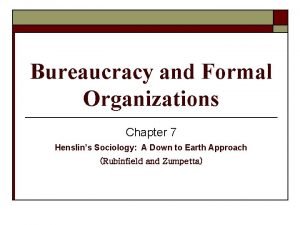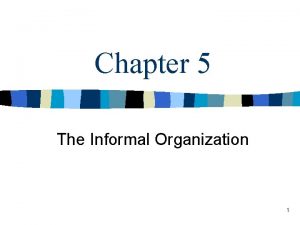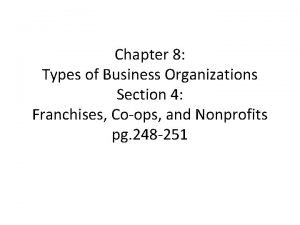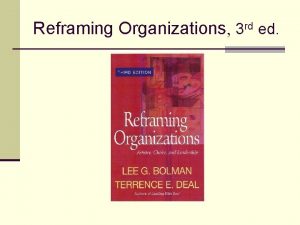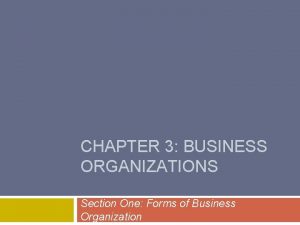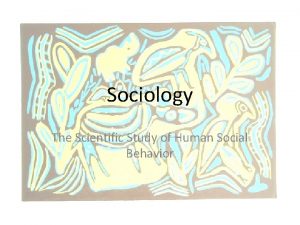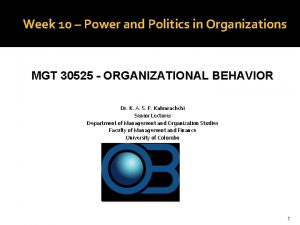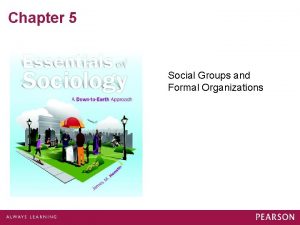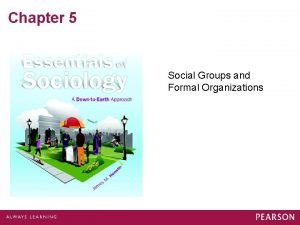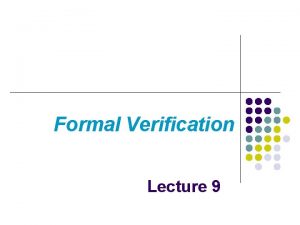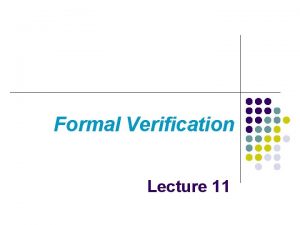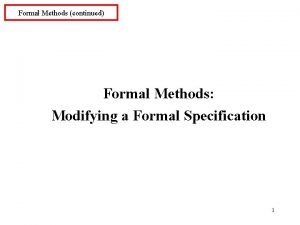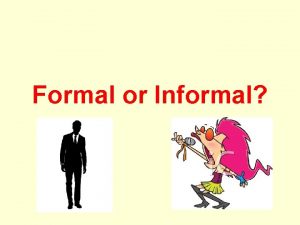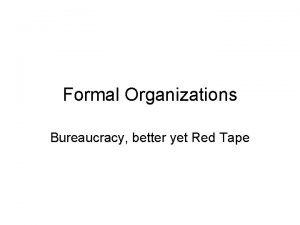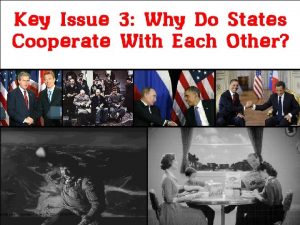Chapter 5 Social Groups and Formal Organizations Groups
























- Slides: 24

Chapter 5 Social Groups and Formal Organizations

Groups Within Society • Definition of Group: People who think of themselves as belonging together and who interact with one another. © 2013 Pearson Education, Inc. All rights reserved.

Groups Within Society • Aggregate: Individuals who temporarily share the same physical space but do not see themselves as belonging together. • Category: People who have similar characteristics. © 2013 Pearson Education, Inc. All rights reserved.

Groups Within Society • Primary Groups: A group characterized by intimate, long-term, face-to-face association and cooperation. – The Family – Friends © 2013 Pearson Education, Inc. All rights reserved.

Groups Within Society • Secondary Groups: These groups are larger, more anonymous, more formal, and impersonal and are based on some interest or activity. – Larger, More Anonymous – Members Interact Based on Statuses – Fail to Satisfy Need for Intimate Association © 2013 Pearson Education, Inc. All rights reserved.

Groups Within Society • Voluntary Associations – Definition: A group made up of volunteers who organize on the basis of some mutual interest. – Combine features of primary and secondary groups – Include national organizations such as girl and boy scouts, AA, NA, and local citizen and other groups (e. g. sports leagues) © 2013 Pearson Education, Inc. All rights reserved.

Groups Within Society • Iron Law of Oligarchy (Robert Michels) – How organizations come to be dominated by a small, self-perpetuating elite. © 2013 Pearson Education, Inc. All rights reserved.

Groups Within Society • Clique: A cluster of people within a larger group who choose to interact with one another. © 2013 Pearson Education, Inc. All rights reserved.

Groups Within Society • In-Groups and Out-Groups – In-Groups: Groups toward which people feel loyalty. – Out-Groups: Groups toward which people feel antagonism. – Loyalty to In-Groups – Antagonism Towards Out-Groups © 2013 Pearson Education, Inc. All rights reserved.

Groups Within Society • Reference Groups – Definition: Group whose standards we refer to as we evaluate ourselves. – Evaluating ourselves – Expose us to contradictory standards © 2013 Pearson Education, Inc. All rights reserved.

Groups Within Society • Social Networks – Definition: The social ties radiating outward from the self that link people together • Interaction takes place within social networks that connect us to the larger society. – The Small World Phenomenon • Milgram his study led to the phrase “six degrees of separation”—meaning that, on average, everyone in the United States is separated by just six individuals. © 2013 Pearson Education, Inc. All rights reserved.

Groups Within Society FORMULA FOR DETERMINING TOTAL NUMBER OF DYADS N/2 (N – 1) N = Total Number of Individuals Estimate total number when N = 12 12/2 (12 – 1) 6 x (11) 66 possible dyads © 2013 Pearson Education, Inc. All rights reserved.

Bureaucracies • Definition: A formal organization with a hierarchy of authority and a clear division of labor; emphasis on impersonality of positions and written rules, communications, and records. • Rationalization of Society: Term coined by Weber to describe the process of how bureaucracies would increasingly dominate our lives. © 2013 Pearson Education, Inc. All rights reserved.

Bureaucracies • Five Characteristics of Bureaucracies – Clear cut levels – Division of Labor – Written rules – Written communication and records – Impersonality © 2013 Pearson Education, Inc. All rights reserved.

Dysfunctions of Bureaucracies • Peter Principle: The members of an organization are promoted for their accomplishments until they reach their level of incompetence; there they cease to be promoted, remaining at the level at which they can no longer do good work. © 2013 Pearson Education, Inc. All rights reserved.

Group Dynamics • Group size affects stability and intimacy – Dyad: Consists of two persons. – Triad: Consists of three persons. – Coalitions: Formed when two group members align themselves against one in a triad. • As size increases, so does stability • As size increases, intensity and intimacy decrease © 2013 Pearson Education, Inc. All rights reserved.

Group Dynamics • Effects of group size on attitudes and behavior • The larger the group… – Greater diffusion of responsibility – Increase in formality – Division into smaller groups © 2013 Pearson Education, Inc. All rights reserved.

Leadership • Leader: Someone who influences the behaviors, opinions, or attitudes of others • Who becomes a leader? • Types of leaders – Instrumental: An individual who tries to keep the group moving toward its goals; also known as a task-oriented leader. – Expressive: An individual who increases harmony and minimizes conflict in a group; also known as a socioemotional leader. © 2013 Pearson Education, Inc. All rights reserved.

Leadership • Leadership Styles – Authoritarian: A leader who gives orders. – Democratic: An individual who leads by trying to reach a consensus. – Laissez-Faire: An individual who leads by being highly permissive. • Leadership Styles in Changing Situations © 2013 Pearson Education, Inc. All rights reserved.

Group Dynamics • • Power of peer pressure Asch experiment Study on conformity Power of authority - Milgram experiment – Administering shocks; turning up voltage • Recent replications consistent with earlier © 2013 Pearson Education, Inc. All rights reserved.

Asch’s Cards © 2013 Pearson Education, Inc. All rights reserved.

Milgram and Obedience Stanley Milgram (1933 -1984) • Ground-breaking research conducted at Yale in the 1950 s • Participants acted as the teacher; the “learner” was a confederate • “Teacher” administered increasingly intense shocks as instructed by experimenter when learner gave wrong answer • 65% of participants continued to the end of the experiment © 2013 Pearson Education, Inc. All rights reserved.

Milgram and Obedience (continued) Milgram’s research scenario maximized obedience: • Participants were volunteers • Participants were alone with experimenter • Experimenter was highly credible authority figure • Setting was highly credible university © 2013 Pearson Education, Inc. All rights reserved.

Group Dynamics • Groupthink: A narrowing of thought by a group of people, leading to the perception that there is only one correct answer, in which to even suggest alternatives becomes a sign of disloyalty. © 2013 Pearson Education, Inc. All rights reserved.
 Social groups and formal organizations
Social groups and formal organizations Formal groups fulfill both and functions in organizations.
Formal groups fulfill both and functions in organizations. Part of the movement to humanize bureaucracy includes
Part of the movement to humanize bureaucracy includes Introduction to management and organization
Introduction to management and organization Chapter 3 information systems organizations and strategy
Chapter 3 information systems organizations and strategy How are ethnic groups and religious groups related
How are ethnic groups and religious groups related Formal and informal group in sociology
Formal and informal group in sociology Chapter 8 business organizations
Chapter 8 business organizations Section 4 other organizations
Section 4 other organizations Chapter 8 business organizations
Chapter 8 business organizations Reframing organizations chapter 3 summary
Reframing organizations chapter 3 summary Chapter 3 business organizations
Chapter 3 business organizations Social thinking adalah
Social thinking adalah Social thinking social influence social relations
Social thinking social influence social relations Informal curriculum
Informal curriculum Unit 1 formal informal and non formal education
Unit 1 formal informal and non formal education Als vs formal education
Als vs formal education Types of formal groups
Types of formal groups Chapter 6 organizational behavior
Chapter 6 organizational behavior Primary vs secondary group
Primary vs secondary group Scientific study of social behavior and human groups
Scientific study of social behavior and human groups Power and politics in organizations
Power and politics in organizations Voluntary health and welfare organization examples
Voluntary health and welfare organization examples Compare and contrast business organizations
Compare and contrast business organizations Communicating in teams and organizations
Communicating in teams and organizations


